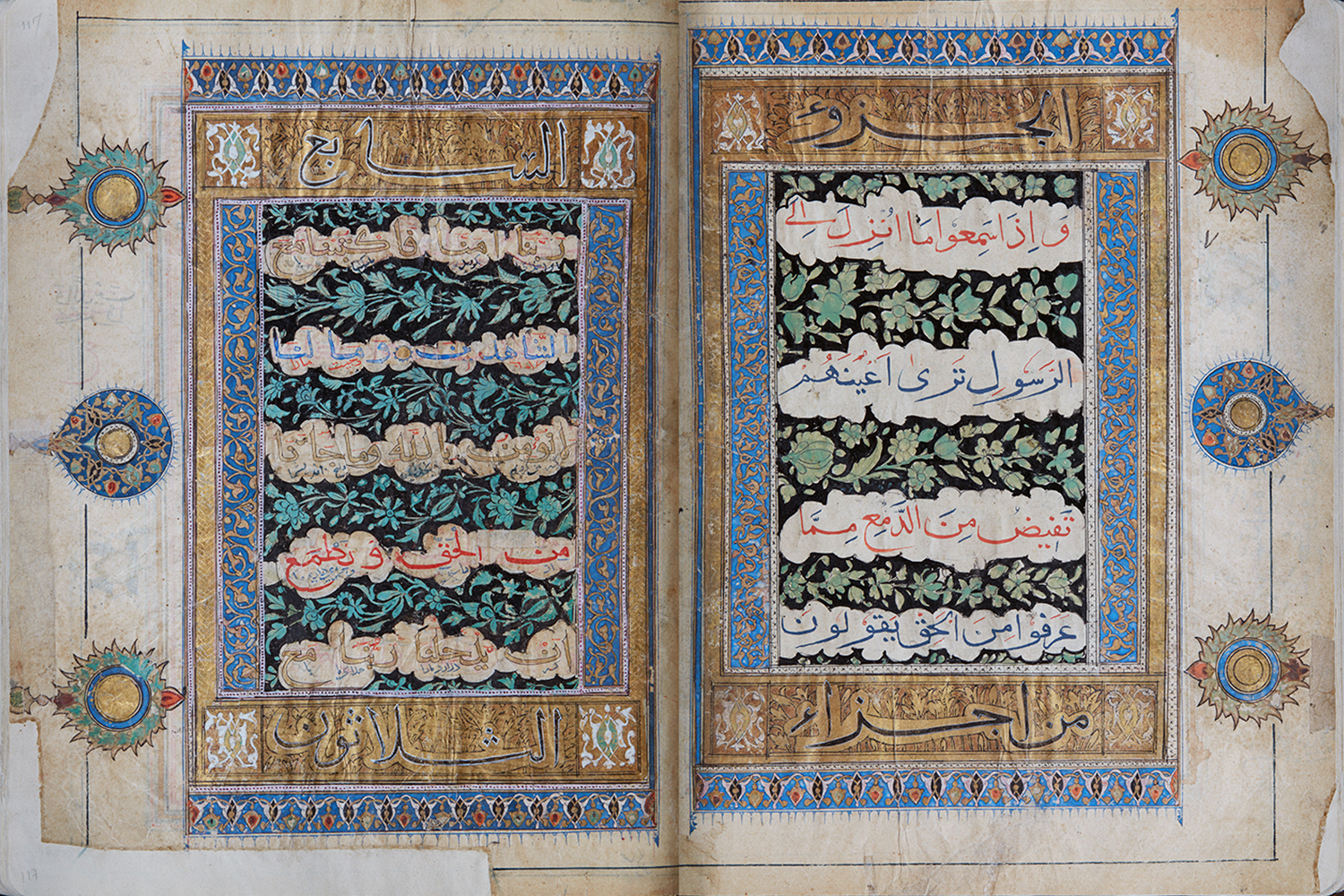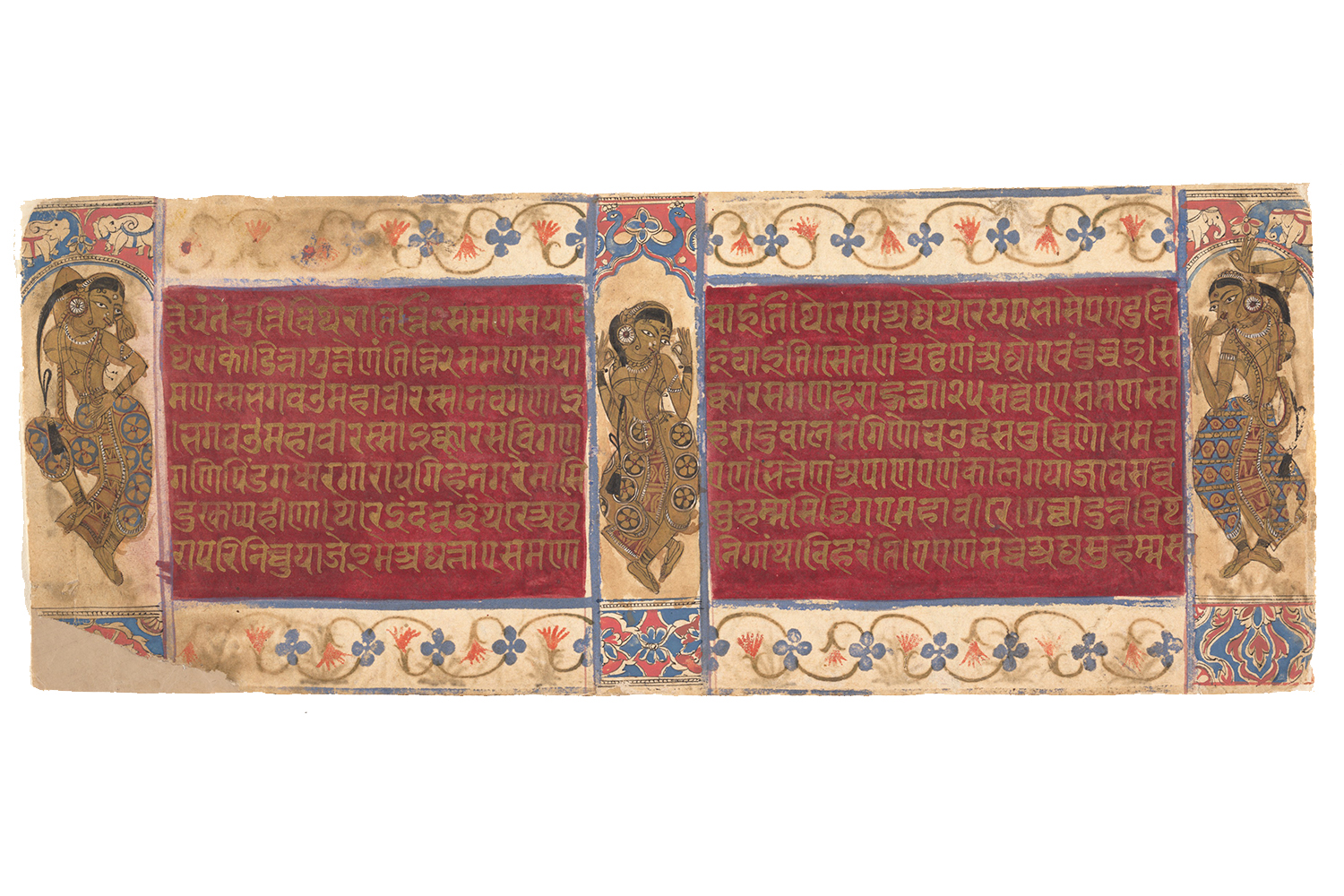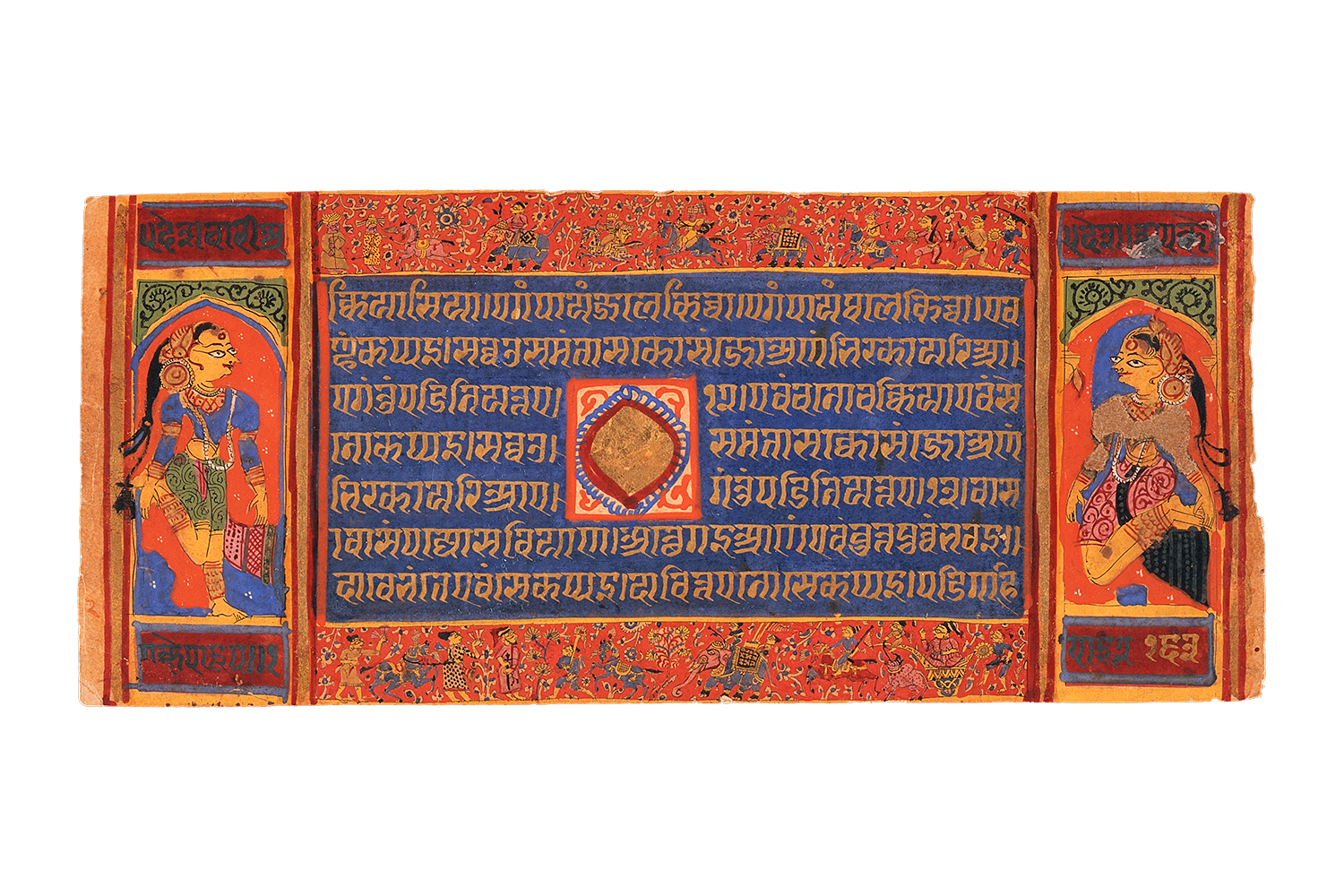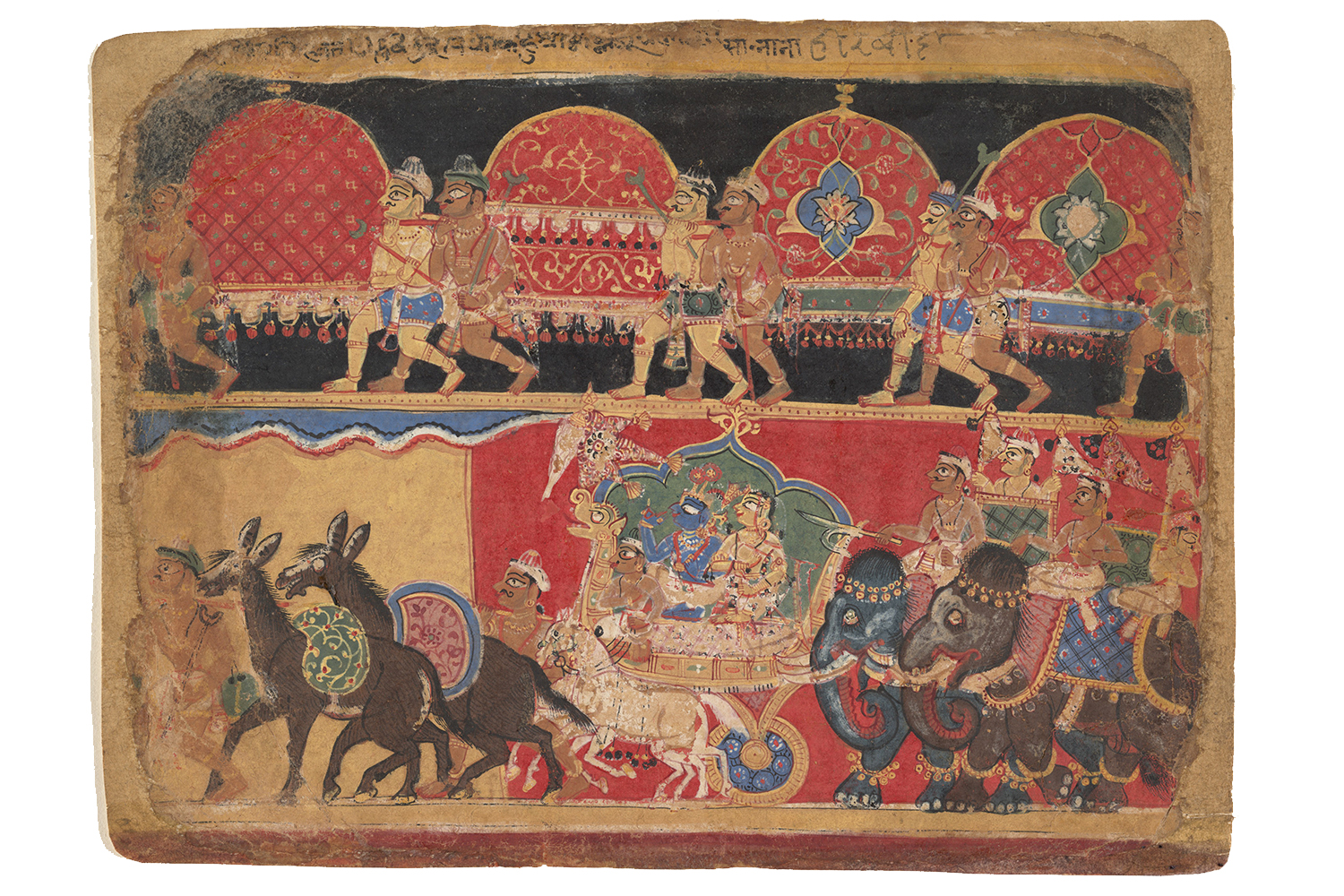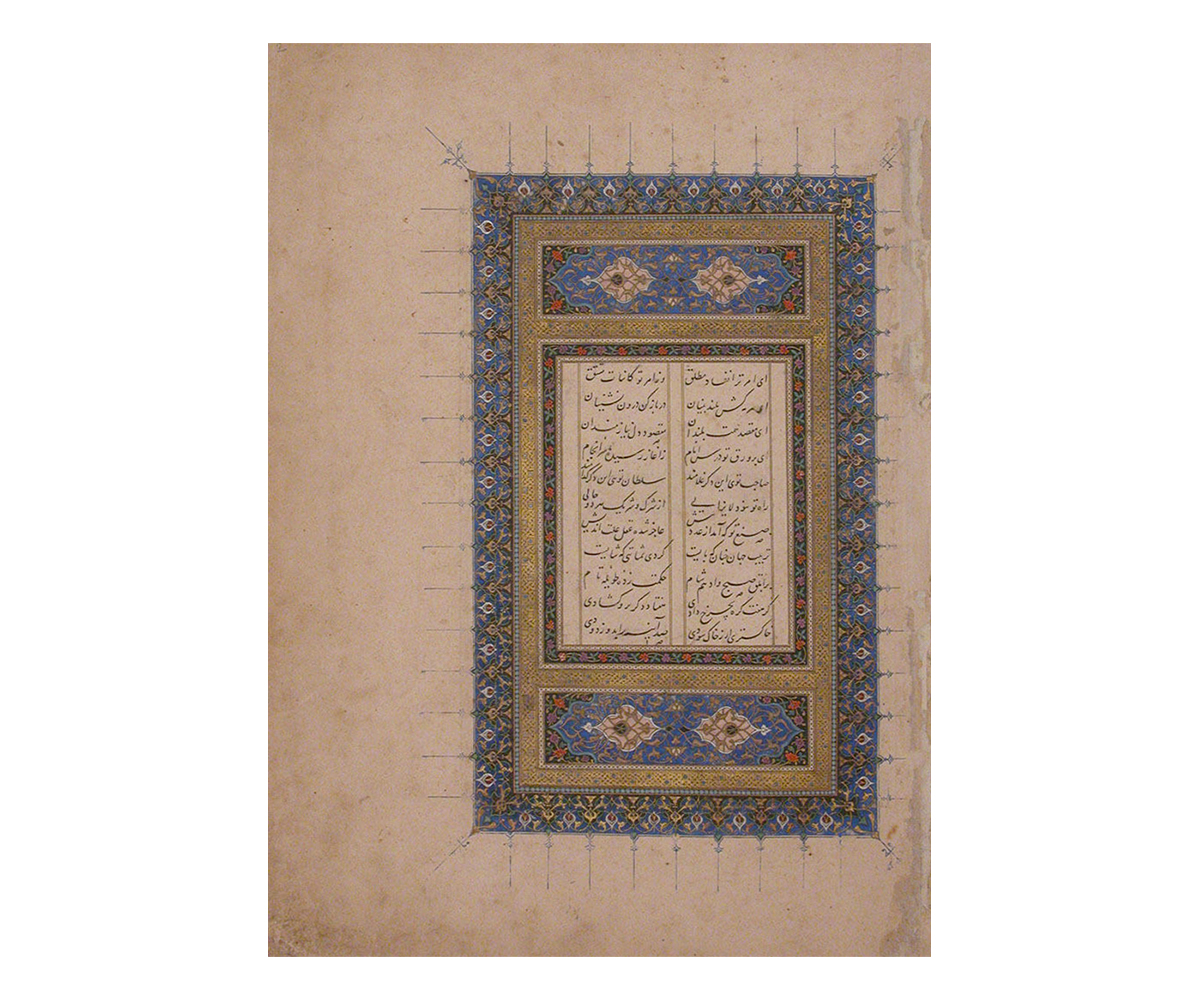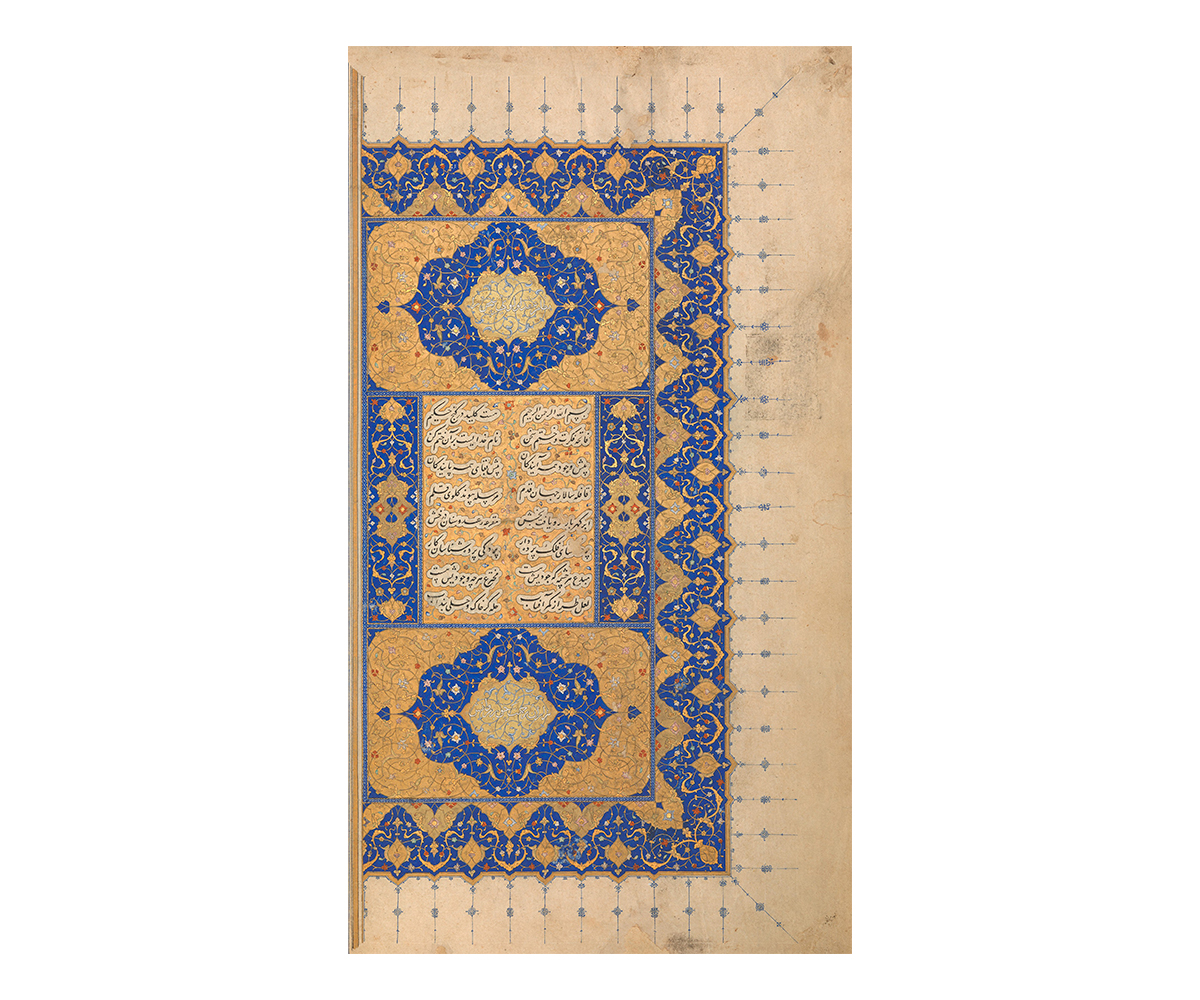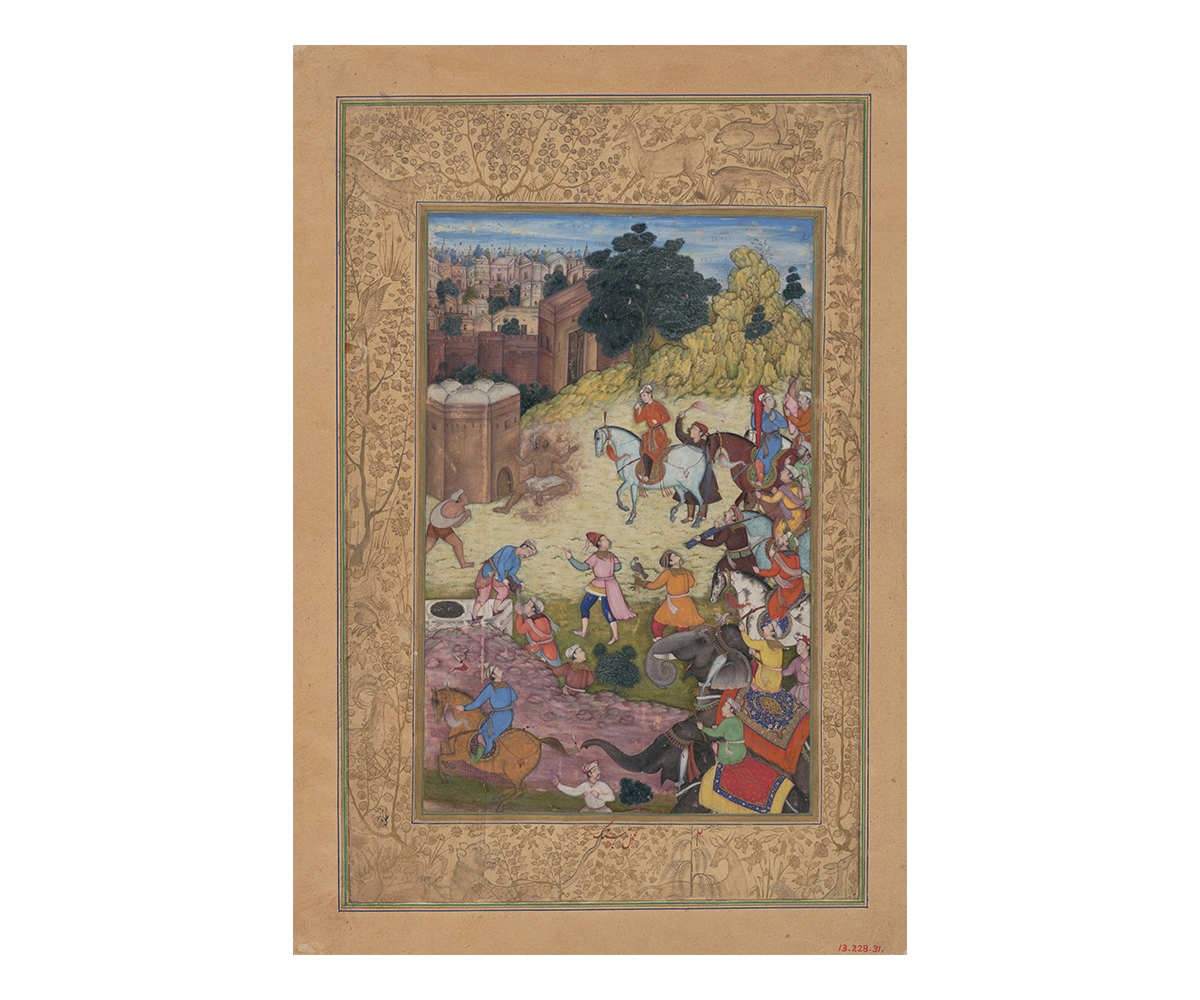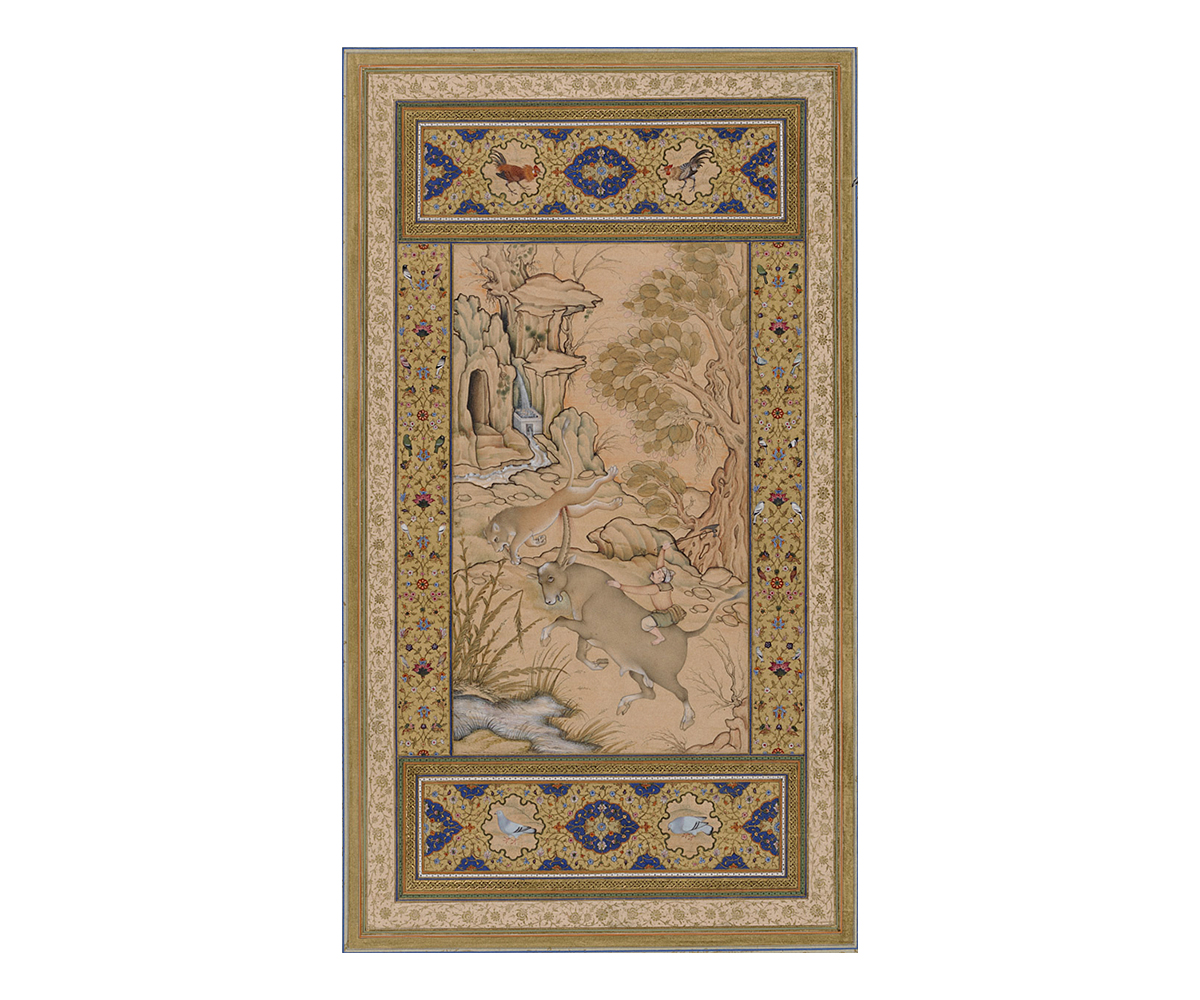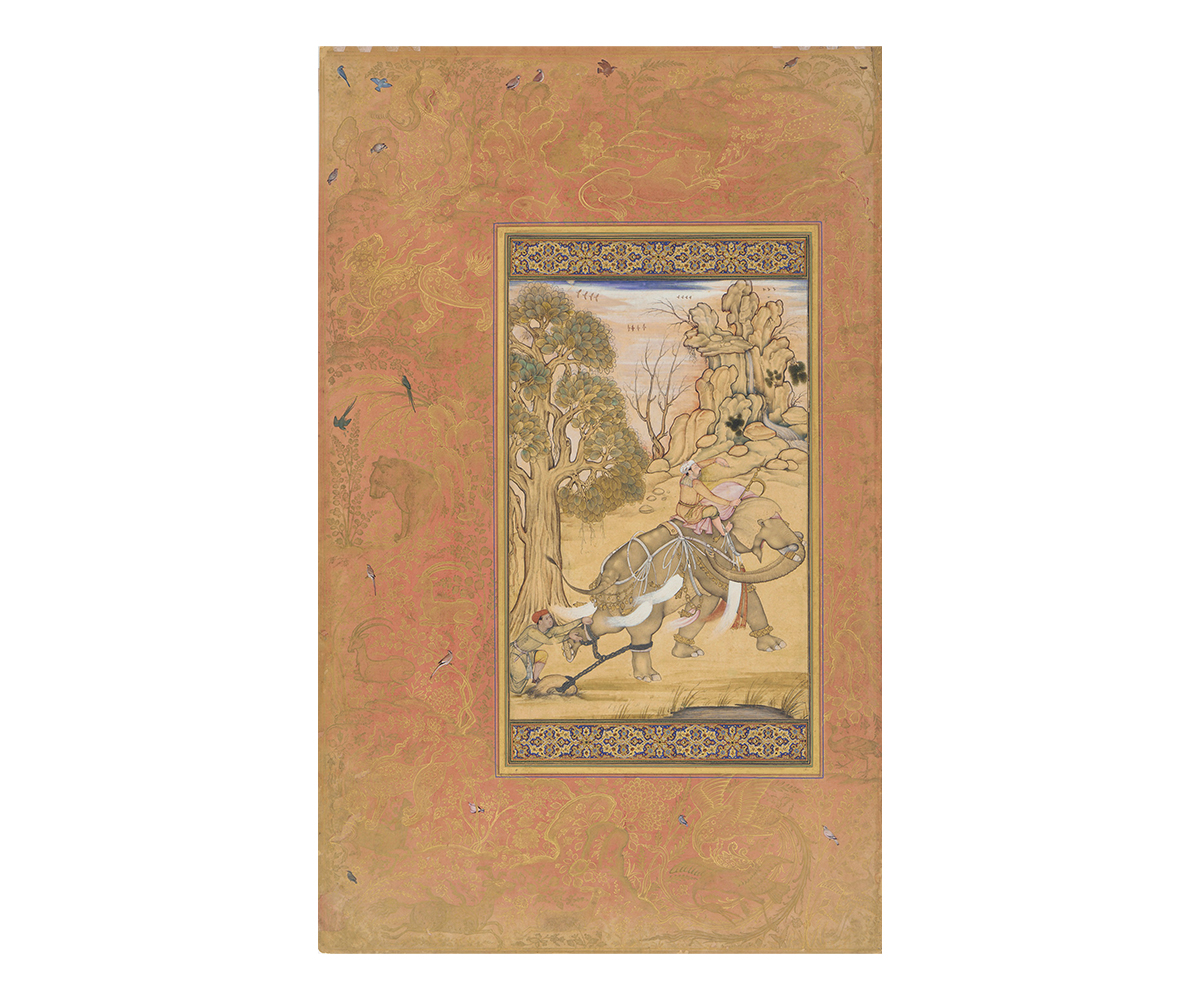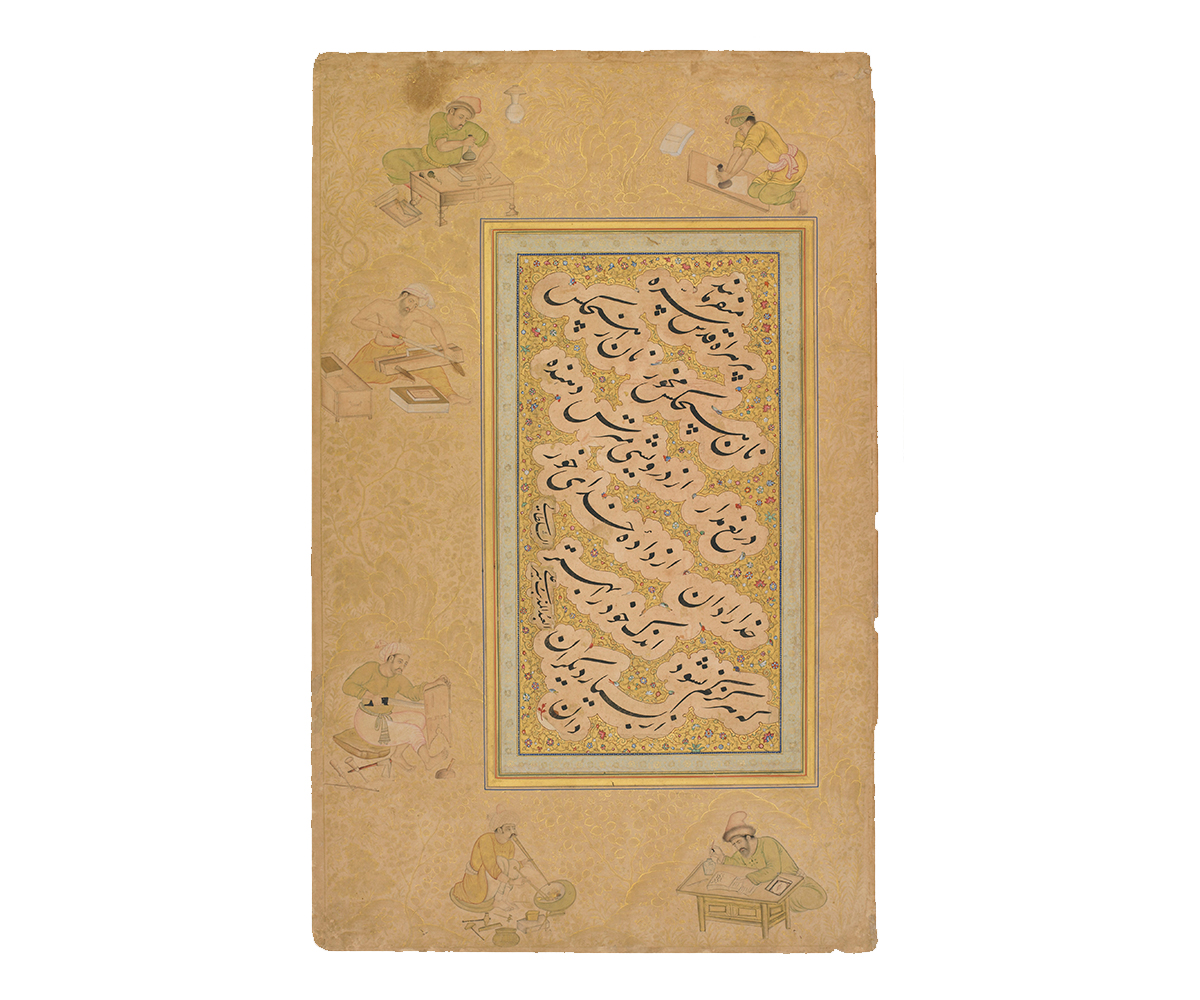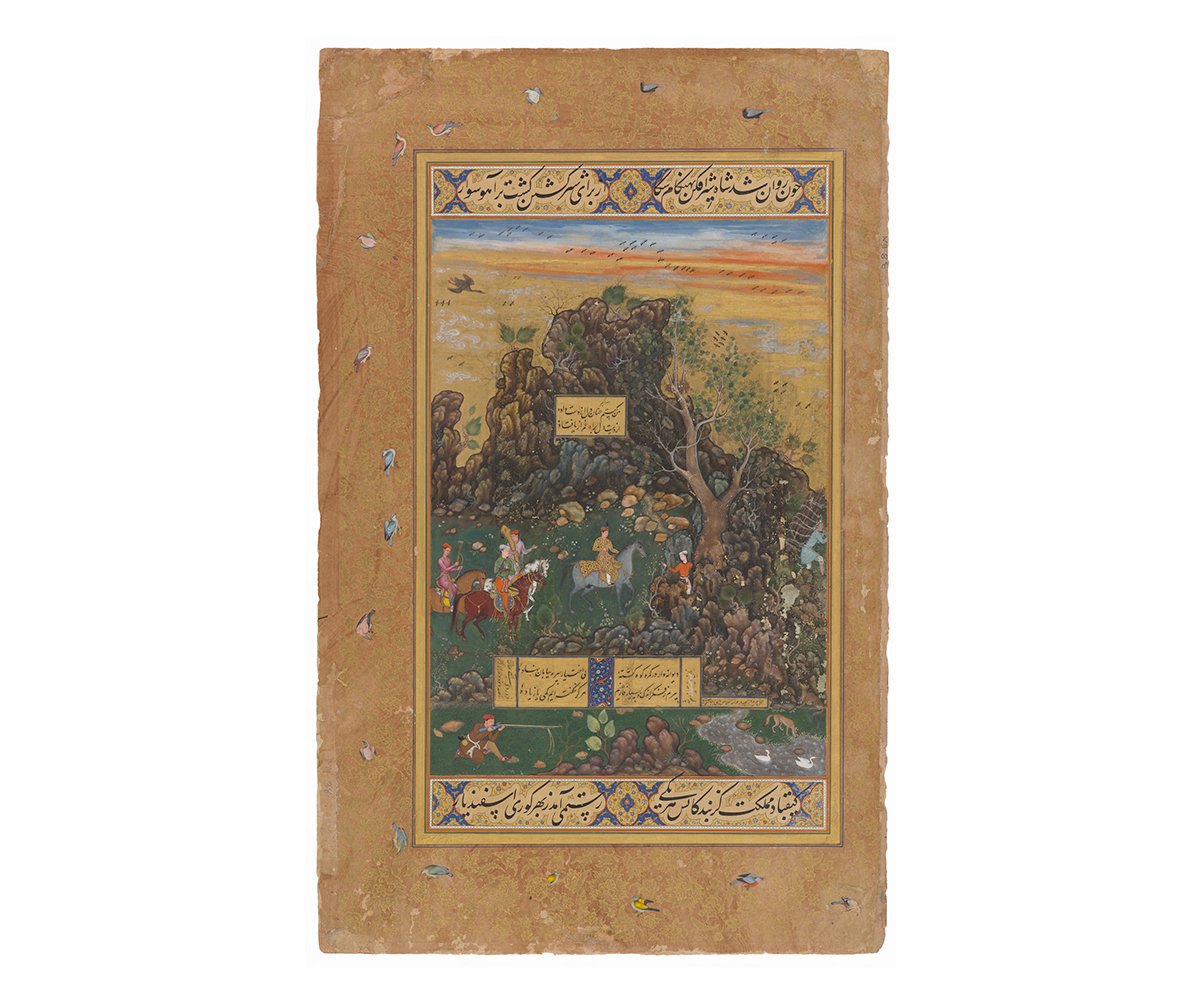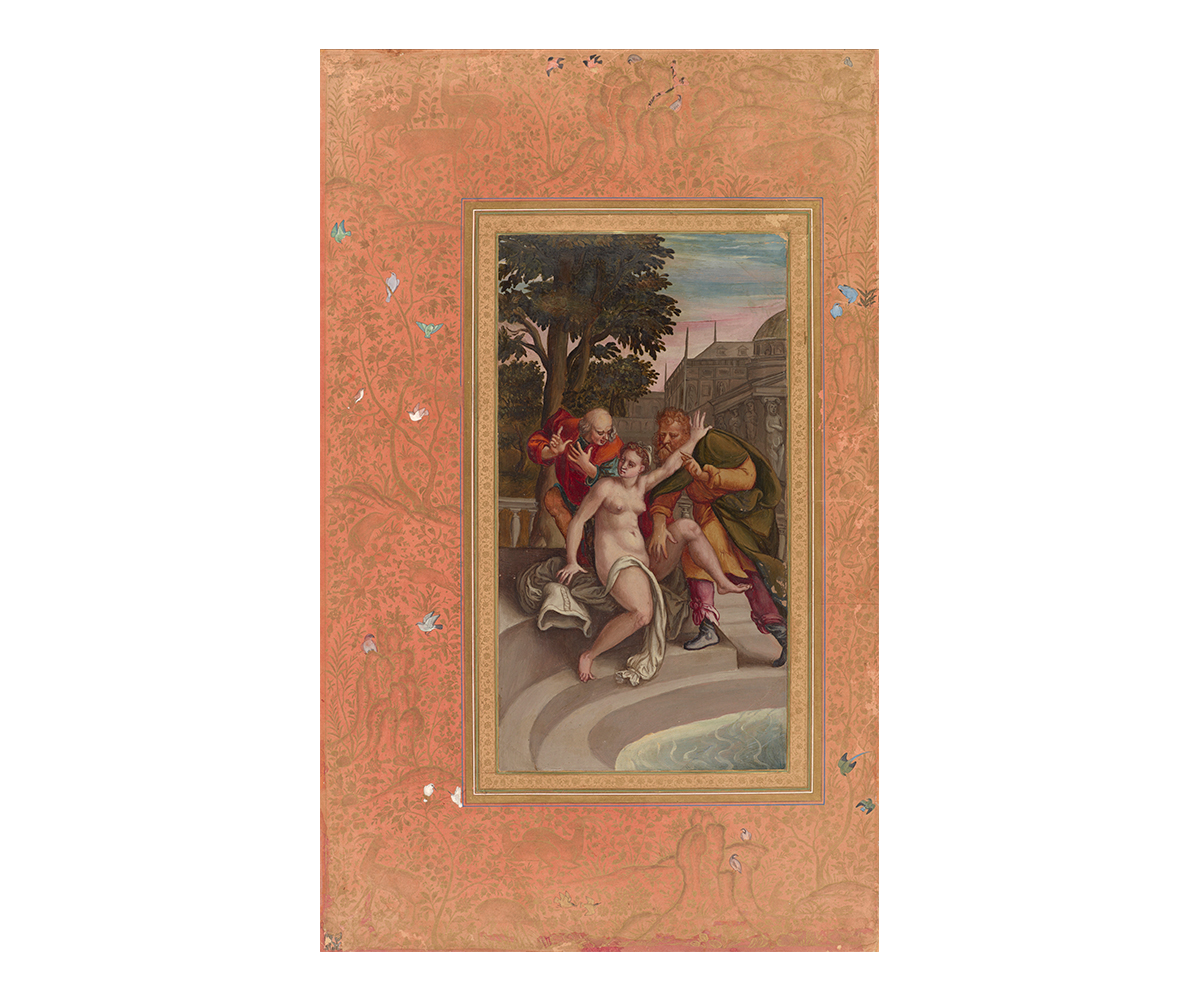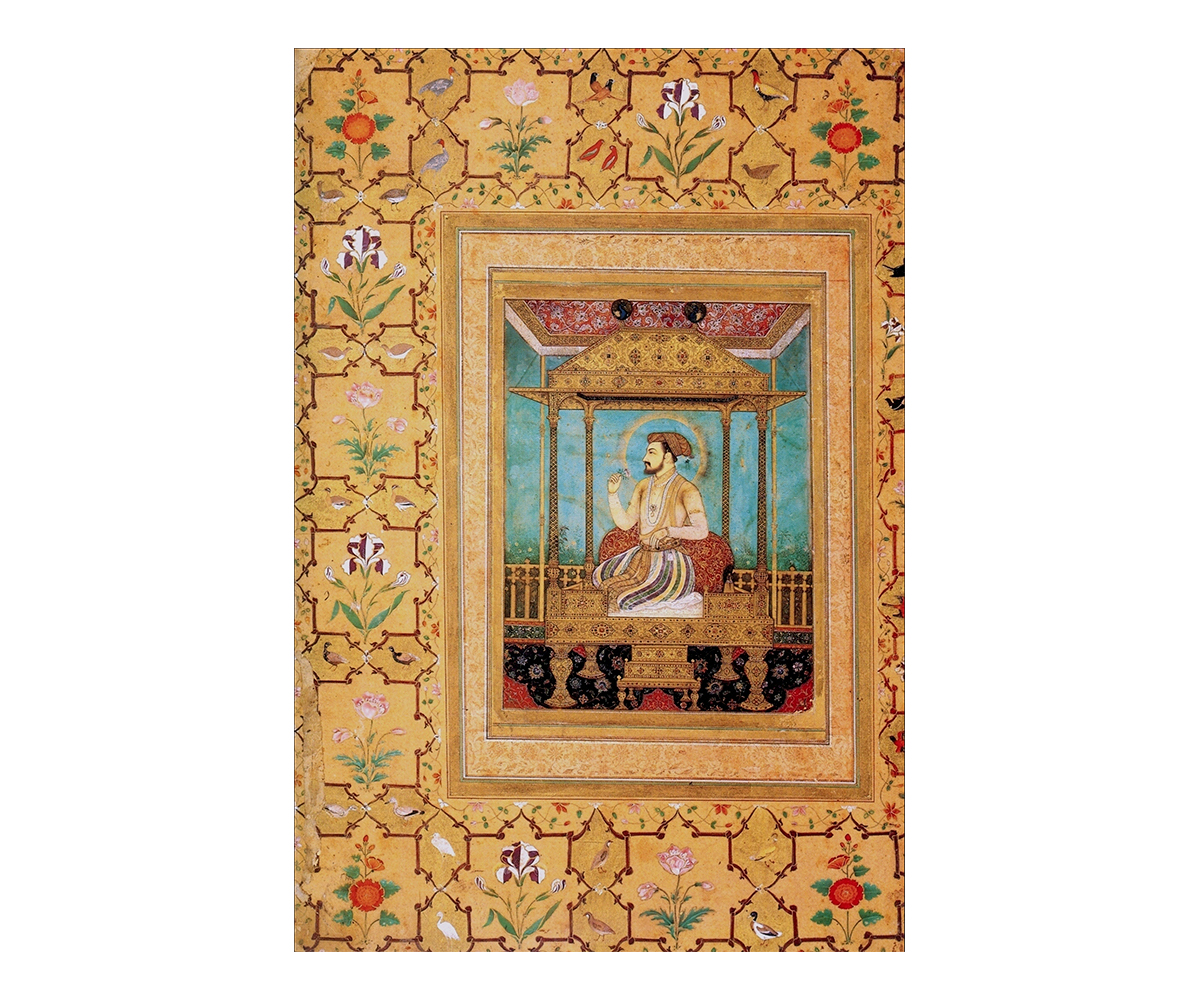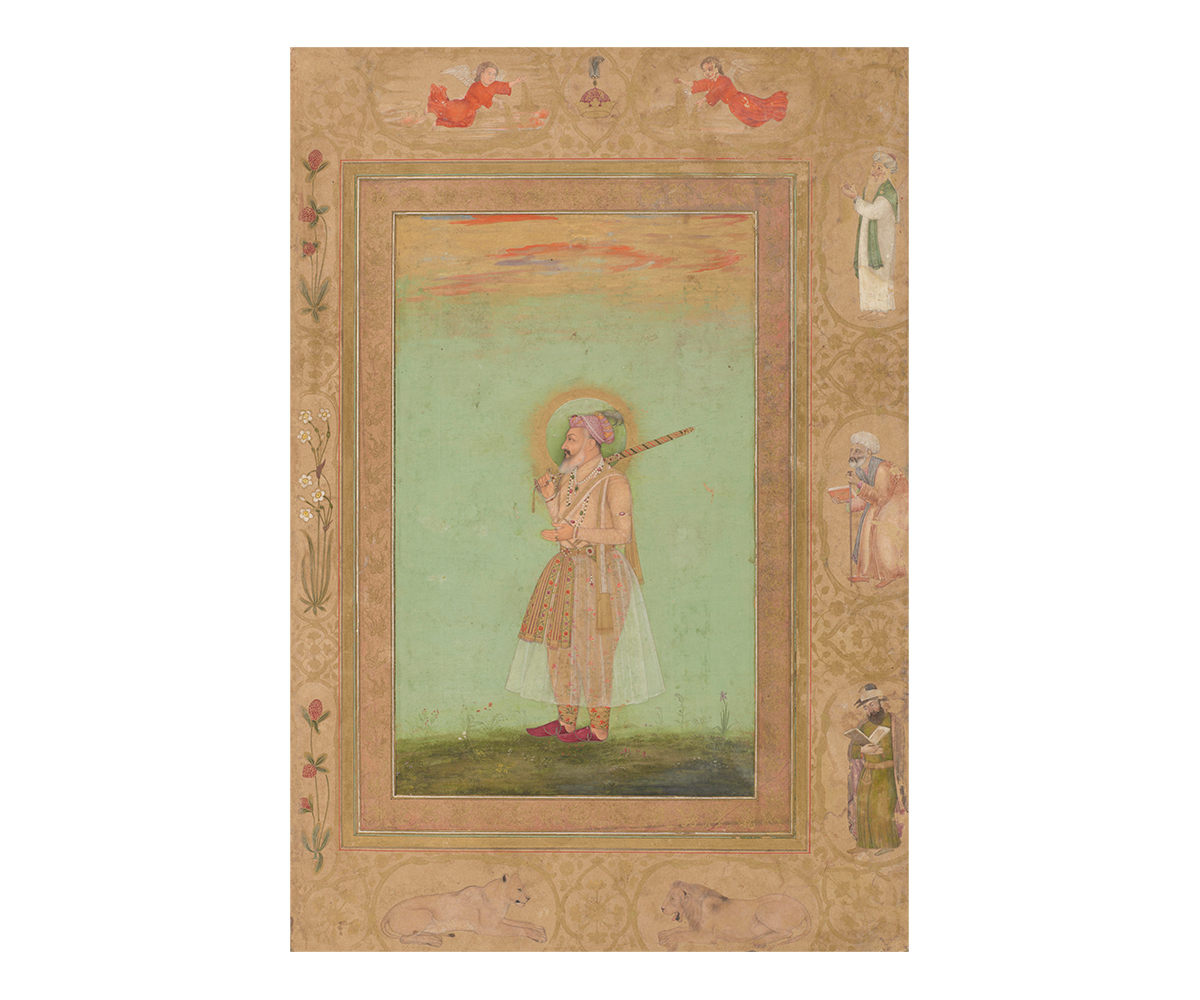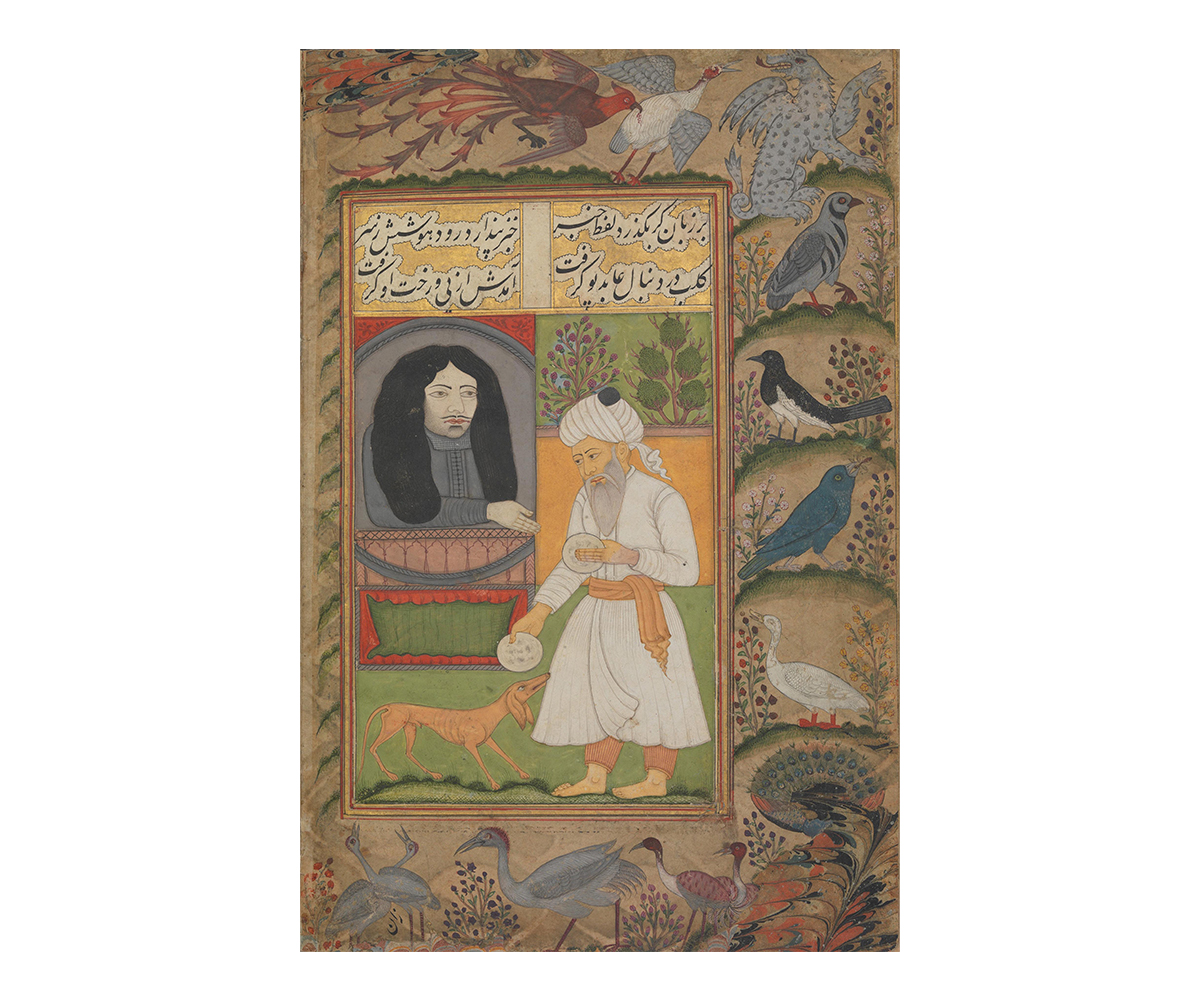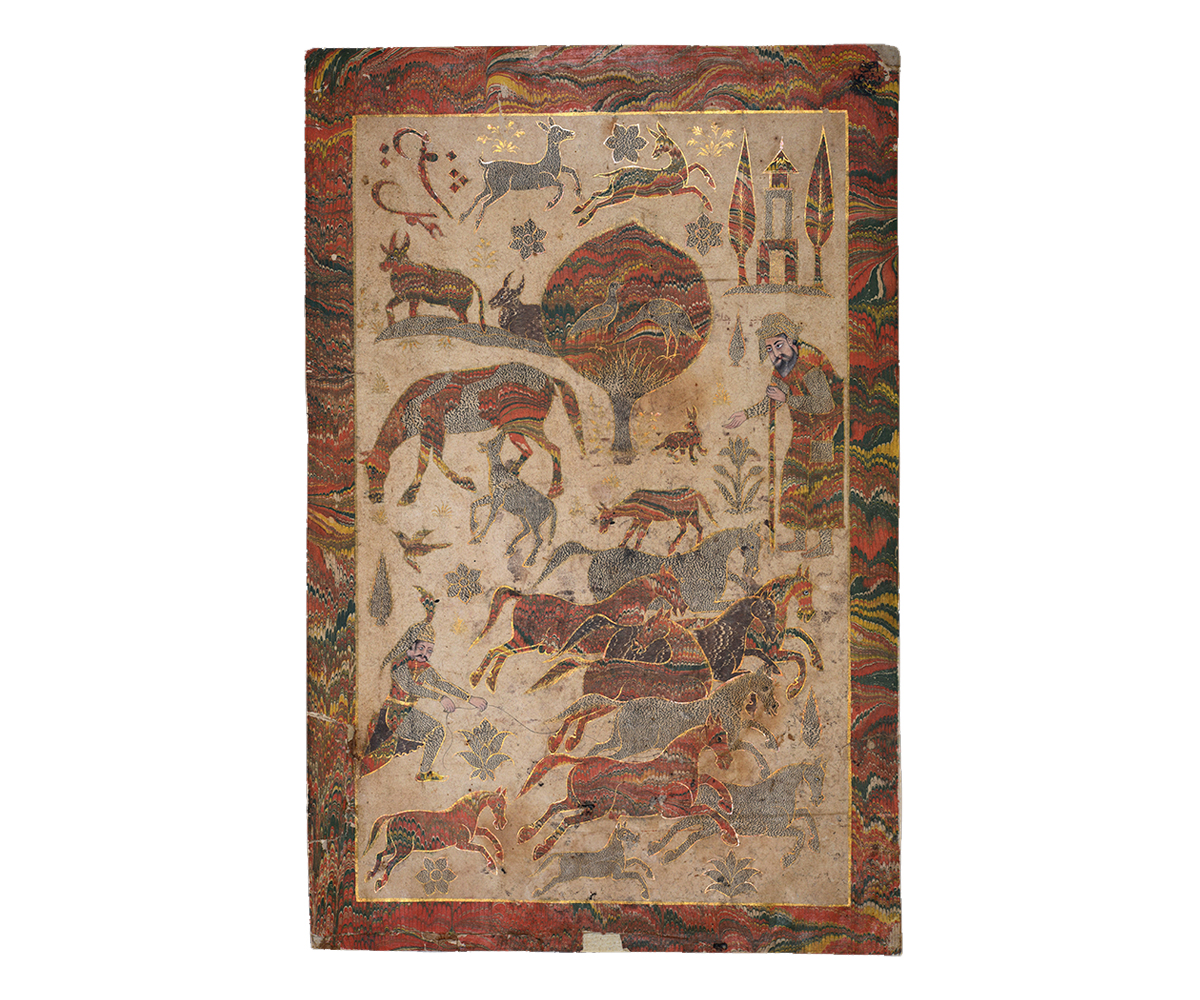ARTICLE
Hashiya
A Persian term meaning ‘border’, ‘edge’ or ‘selvedge’, hashiya refers to the margin around the central image or text in a manuscript or album. Originating in Central Asia, the practice of hashiya decoration in Indian miniature painting flourished in the Mughal ateliers of the sixteenth and seventeenth centuries, where margin-makers occupied a distinct category of artisans involved in manuscript production. Hashiya painting was typically used to embellish the space around an artwork or calligraphy once it was pasted onto a folio. From simple ornamental additions demarcating the matn, or main field of text, hashiyas evolved into richly illustrated borders that became an essential feature of Mughal miniature painting.
In the Islamic tradition, the practice of illuminating manuscripts with margin decorations began soon after the founding of the religion, with its earliest instances seen in Quran manuscripts, where it comprises abstract or floral decorative patterns and motifs. This became the basis for the illuminated manuscript tradition that flourished in the Timurid and Safavid empires of West and Central Asia in the fifteenth and sixteenth centuries. The demand for painting and calligraphy in a more accessible format resulted in the popularisation of muraqqas (‘patchworks’ in Persian) — albums in which paintings, sketches, engravings and pieces of calligraphy by various artists were assembled according to a careful narrative or visual logic. These pasted items had very different sizes, leaving margins of varying widths around them. Moreover, while a single-text manuscript maintained a uniformity of hashiya decoration across its pages or folios, a muraqqa by its nature would feature a variety of hashiyas. This gave artists the opportunity to create inventive hashiya decorations, serving any of a myriad of functions. While some hashiyas merely added an adornment complementing the main image or text, others offered an extension of meaning or commentary for the central subject, and sometimes wove an independent narrative that ran across the hashiyas of multiple pages.
While borders were sometimes used in early Indian manuscripts, they are generally thought to have taken a simple and utilitarian form prior to Persian influence. Eleventh- and twelfth-century Buddhist palm-leaf manuscripts of the Pala period — among the oldest surviving illustrated manuscripts in South Asia — sometimes bore painted bands on their edges. These bands of ruled lines allowed the reader to hold the folio without staining or damaging the area of the text body, and thereby served a protective function. This margin space also contained holes to allow the manuscript to be bound together using strings. Known as jadwal or khat, it became a characteristic feature of Jain manuscripts in Gujarat and Rajasthan, when they began to be made with paper from the fourteenth century onwards. The manuscript painting traditions of the Rajput and Pahari courts similarly used bands of colour, usually red, to demarcate margins, painted either by the manuscript’s artist himself or by an apprentice.
An early form of hashiya in India is seen in the Gwalior Quran of 1399, in which the Bihari writing is illuminated with ornamental borders. They contain lotus petal and medallion motifs, further surrounded by arabesque outer margins, much like those seen in fourteenth-century Quran manuscripts made under the Mamluk dynasty in Persia and Egypt.
By the late fifteenth century, Jain manuscripts began to show Persianate influences, speculated by scholars to be linked to two developments. The establishment of the Gujarat Sultanate in the early fifteenth century brought the artists of the region under the patronage of Muslim nobles who would have been familiar with Persian traditions. Secondly, as an important commercial port in the subcontinent’s trade with West and Central Asia, Gujarat received sailors and merchants from Persia, and the illuminated manuscripts and muraqqas they brought with them would have influenced the artists of the region. These influences are seen in the adoption of a vibrant palette of ultramarine, crimson and gold, as well as detailed renderings in manuscript illustration.
Some manuscripts also showed richly decorated margins filled with floral and figural designs, such as the Devasano Pado Kalpasutra produced in Gujarat in the late fifteenth century. In addition to intricate floral patterns inspired by Persianate art, the manuscript’s wide borders also feature female figures and hunting and procession scenes, which are used to visually enhance the folio rather than illustrate the text. Such hashiya painting was not, however, absorbed into Western Indian painting schools of the time, which continued with their use of jadwal, or disregarded borders altogether, as in the Chaurapanchasika paintings where the text and parts of the central illustration both extend to the folio edges.
It was in the Mughal ateliers of the sixteenth and seventeenth centuries that hashiya painting in the Persian tradition was prominently adopted in the Indian subcontinent. These imperial ateliers brought together professional artists with expertise in various areas of bookmaking, and with this, the role of the hashiyakash or ‘margin maker’ became a specialised one. The most significant examples of Persian influence can be found in a series of deluxe manuscripts produced in the 1590s by Akbar’s (r. 1556–1605) atelier, such as the Khamsas of Nizami Ganjavi and Amir Khusrau, and Baharistan by Jami, the latter of which was also noted for its hashiyas of arabesques, geometric designs, and bird and animal motifs rendered in gold.
Hashiya illumination reached its apogee in the muraqqas of this period, particularly during the reigns of Jahangir (r. 1605–27) and Shah Jahan (r. 1628–58). From the reign of Jahangir onwards, the hashiya is thought to have become a space for master artists of the imperial workshop to adopt a variety of visual styles, themes and subjects, ranging from abstract floral or geometric patterns in the Persian style to narrative figural drawings and paintings in the European style. The Gulshan Album commissioned by Jahangir demonstrates a convention in which the hashiyas around illustrations contain only floral and arabesque patterns, while those surrounding calligraphic text contain detailed figural illustrations in addition to abstract motifs. The hashiya of one such page, attributed to an artist named Madhava (active 1582–c. 1624), depicts six artisans at work, each carrying out a different step in the process of manuscript making, from preparing the paper and folios to creating the calligraphy. Another calligraphy page from the Gulshan Album depicts finely rendered figures in the European Biblical style in its hashiya, attesting to the influences of Renaissance and Baroque art that Mughal artists had access to in their ateliers.
While hashiya patterns and motifs served a largely decorative purpose in Jahangir’s ateliers, they began to relate more directly to the central image during Shah Jahan’s reign. A folio bearing a portrait of Shah Jahan, for instance, is decorated with margin figures of angels carrying parasols and attendants with fly-whisks, underlining the ruler’s celestial authority. Similar figures are seen in the margin above a contemporaneous portrait of Akbar on a horse; however, this hashiya also contains elements of a royal hunting expedition — figures of falconers and a gun-bearer, as well as game animals and birds. In this way, the hashiya creates a narrative around a painting that would otherwise be simply an equestrian portrait. In a folio from a muraqqa made in Shah Jahan’s later years, the hashiya illustrations act as an instrument of dramatic irony. A painting of a scene from Ganjavi’s narrative poem Layla-Majnun shows a kneeling Majnun as he grieves the separation from his beloved Layla. In the hashiya, however, she is shown approaching him atop a camel in the distance, complementing the painting’s message with a different part or aspect of the narrative, that of reunion.
The scholar Stuart Cary Welch identified a notable hashiyakash who worked in Shah Jahan’s atelier and is now known only as ‘Master of the Borders’. His work shows the influence of painting styles from the Deccan, from where he is thought to have migrated, and a colour palette that is brighter and more varied than was used in the Mughal ateliers. An example of his distinctive style is seen in his hashiya for Shah Jahan on the Peacock Throne (c. 1635) by Govardhan — he borders the emperor’s lavish portrait with an elegant geometric pattern interspersed with detailed illustrations of flowering plants and birds, evoking a Mughal garden.
By the late seventeenth century, however, Deccani manuscript painting itself came heavily under the influence of the Mughal style, following the conquests of Deccan sultanates such as Ahmadnagar and Bijapur. In their hashiyas, these manuscripts feature intricate floral and arabesque designs, often rendered in gold, as well as rich depictions of fauna. Folios from a Nan va Halva manuscript made in Aurangabad around 1690 show prominent hashiyas densely populated with birds, animals and mythical creatures in animated poses. Paintings and calligraphy in Deccani manuscripts and muraqqas were also often framed with paper treated with abri or ‘clouding’ — an East Asian and Persian marbling technique that imparted a unique swirl pattern to each sheet.
While the hashiya became a distinctive and essential feature of Mughal manuscript painting, its development and role were little examined until the late 1970s. In 2018, art historian Kavita Singh conceptualised a group exhibition titled Hashiya at the Anant Art Gallery in New Delhi, exploring the contemporary interpretation of hashiya as a space for varied artistic expression. The exhibition featured work by contemporary artists, including Gulammohammed Sheikh, Nilima Sheikh, Desmond Lazaro, Alexander Gorlizki, Ghulam Mohammad, Nusra Latif Qureshi and Saira Wasim.
Bibliography
Goswamy, B. N. “Hashiya: Margin / Border / Comment.” In Hashiya: The Margin. New Delhi: Anant Art Gallery, 2018.
Goswamy, B. N. The Spirit of Indian Painting. Close Encounters with 101 Great Works 1100–1900. New Delhi: Penguin Random House India, 2014.
Guy, John, and Jorrit Britschgi. Wonder of the Age: Master Painters of India 1100–1900. New York: The Metropolitan Museum of Art, 2011.
“Illumination.” In The Grove Encyclopedia of Islamic Art and Architecture, Volume 2, edited by Jonathan M. Bloom and Sheila S. Blair, 185–91. New York: Oxford University Press, 2009.
Losty, Jeremiah P. The Art of the Book in India. London: The British Library, 1982.
Najat Haider, Navina, and Marika Sardar. Sultans of Deccan India 1500–1700: Opulence and Fantasy. New York: The Metropolitan Museum of Art, 2015.
Pal, Pratapaditya. Indian Painting, Volume 1: 1000–1700. Los Angeles: Los Angeles County Museum of Art, 1993.
Seyller, John. “Pearls of the Parrot of India: The Walters Art Museum ‘Khamsa’ of Amīr Khusraw of Delhi.” The Journal of the Walters Art Museum 58 (2000): 5–176. http://www.jstor.org/stable/20168592.
Singh, Kavita. “Hashiya: A Border, a Margin, a Frame.” In Hashiya: The Margin. New Delhi: Anant Art Gallery, 2018.
Verma, S. P. “Margin-Painting in Medieval Indian Art.” Proceedings of the Indian History Congress 40 (1979): 460–66. http://www.jstor.org/stable/44141985.
Welch, Stuart Cary. India: Art and Culture 1300–1900. New York: The Metropolitan Museum of Art; Holt, Rinehart and Winston, 1985.




